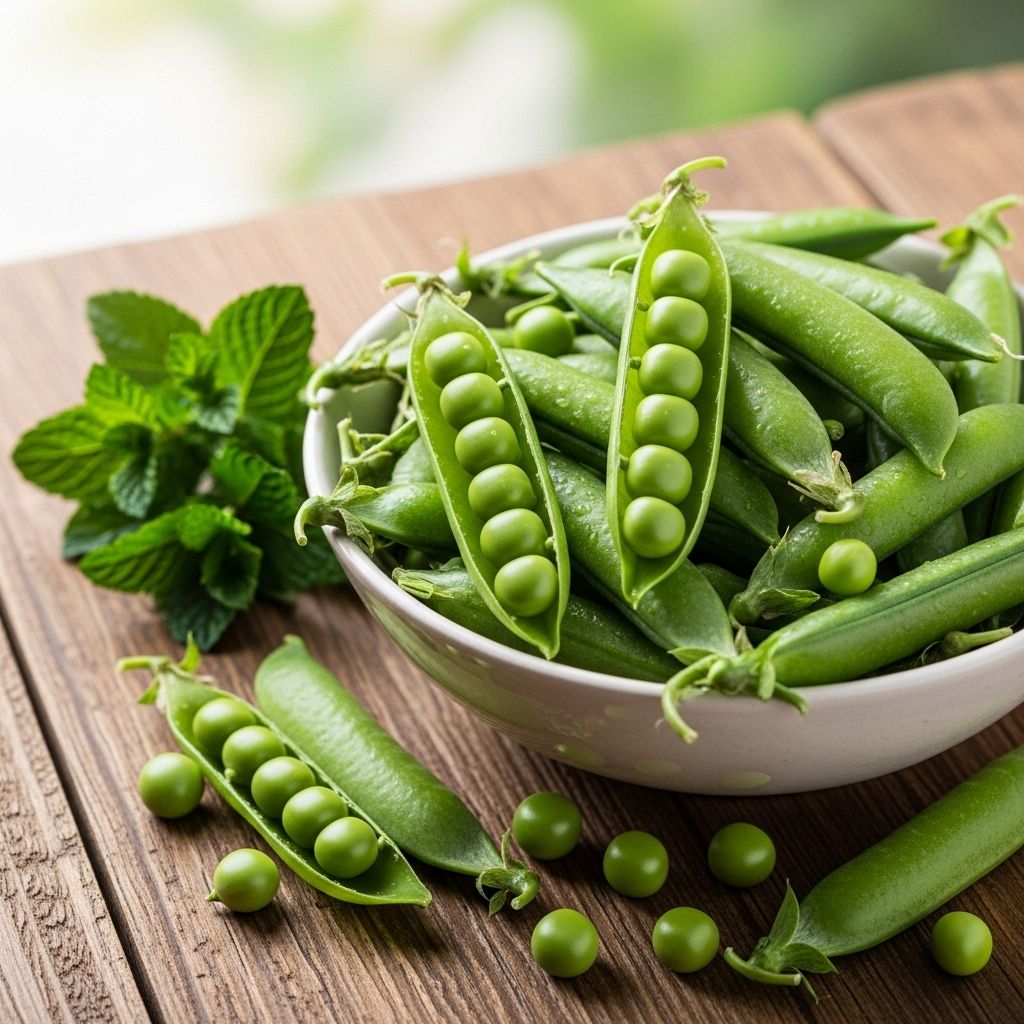6 Science-Backed Benefits of Green Peas for Health, Digestion, and More
Packed with plant protein, fiber, and antioxidants, this legume nourishes your body.

Green Peas: Surprising Health Benefits and Nutrition Facts
Green peas (Pisum sativum), also known as garden peas, are more than just a simple side dish—they’re a nutritional powerhouse with wide-ranging health advantages. This article explores the science-supported benefits of green peas, their nutritional content, and their culinary versatility.
What Are Green Peas?
Green peas are the seeds found inside the pods of the annual climbing plant Pisum sativum, originating from Southeast Asia. As a legume, peas belong to the same family as chickpeas, lentils, and beans, though they are often classified as vegetables in culinary contexts.
Green peas rank fourth globally in legume production. In the U.S., peas are quite popular, consumed in various forms: raw, boiled, steamed, and stir-fried. Their mild sweetness comes from their natural starch content.
A survey shows 71% of Americans enjoy peas, with strong popularity across generations—from baby boomers to millennials.
Nutritional Value of Green Peas
| Nutrient | Amount per 1 cup (boiled, unsalted) |
|---|---|
| Calories | 134 |
| Protein | 8g |
| Fiber | 9g |
| Carbohydrates | 11g |
| Vitamins/Minerals | Lutein, Zeaxanthin, Phosphorus, Vitamin A & K |
Green peas are rich in essential nutrients, plant-based protein, antioxidants, and prebiotic fibers—making them beneficial for various aspects of health.
Key Takeaways
- Versatile & Mildly Sweet: Green peas can be enjoyed raw, boiled, steamed, or as stir-fried pods.
- Digestive Health: Their high fiber helps regulate digestion and detoxifies the body.
- Antioxidant & Anti-Inflammatory: Peas combat oxidative stress and inflammation.
- Possible Adverse Effects: Excessive consumption may cause digestive issues due to anti-nutrients, which can be reduced by proper preparation.
Health Benefits of Green Peas
1. May Help Manage Blood Sugar and Diabetes
Green peas are low on the Glycemic Index thanks to their high dietary fiber content, which slows carbohydrate breakdown and helps prevent post-meal sugar spikes.
Low GI foods are valuable for managing and preventing type 2 diabetes.
Animal studies (in mice) show raw pea extracts may inhibit pancreatic amylase—a carbohydrate-digesting enzyme—contributing to their hypoglycemic effect. While promising, more human trials are needed to fully confirm these anti-diabetic properties.
- Peas keep blood sugar steady by slowing digestion.
- Useful for those seeking stable energy and reduced diabetes risk.
2. May Improve Digestion
Peas are rich in prebiotic sugars and fiber, both crucial for digestive health.
The galactose oligosaccharides in peas feed probiotic bacteria, which then produce beneficial compounds for your body.
Fiber speeds food transit through the digestive tract and ensures regular elimination of toxins. Sprouted pea phenolic extracts have shown antimicrobial activity, including inhibiting the growth of Helicobacter pylori, a bacteria linked to ulcers.
- Supports beneficial gut flora.
- Promotes regular bowel movements and reduces constipation.
- May limit harmful bacteria in the gut.
3. May Promote Healthy Weight
Peas are high in both protein and fiber, which increase satiety and reduce cravings for calorie-dense snacks. Eating fiber-rich, protein-rich meals like peas makes you feel fuller for longer, aiding healthy weight management.
- Helps control appetite and lowers calorie intake.
- Protein from peas is particularly valuable for vegetarians/vegans.
4. May Fight Inflammation and Oxidative Stress
Peas are loaded with phytonutrients, polyphenols, and antioxidants—your body’s frontline against free radicals that contribute to chronic inflammation and disease.
- Antioxidants in peas protect cells from damage.
- May lower risk for heart disease, cancer, and other chronic conditions.
5. May Protect Heart and Eye Health
Lutein and zeaxanthin, the carotenoids responsible for peas’ green color, are linked to eye health. Studies show these compounds protect against blue light damage, potentially lowering the risk of age-related macular degeneration.
Phosphorus and certain minerals in peas contribute to heart health by supporting blood vessel function and lowering blood pressure.
- Supports retina and visual health.
- May reduce risk of hypertension and arterial disease.
6. May Strengthen Immunity and Bones
Peas provide essential amino acids, vitamins, and phytonutrients that support immune system function and bone health. Anecdotal evidence links regular pea intake with improved bone mineral density, possibly due to phosphorus content. Scientific research, however, is still limited.
- Rich in vitamin K for bone and immune function.
- Phytonutrients help the body fight infections.
Ways to Eat and Prepare Green Peas
Green peas are highly adaptable in the kitchen. You can boil, roast, sauté, or air fry them, and they’re available fresh, frozen, canned, or dried. Their mild flavor fits into many global cuisines—salads, soups, stir-fries, curries, and more.
- Popular preparations: raw, steamed, stir-fried pods.
- High versatility for vegetarian and vegan recipes.
- Pea protein powders offer a concentrated source of plant protein.
Reducing Anti-Nutrients in Peas
Peas contain natural anti-nutrients that may hinder digestion or nutrient absorption. To minimize these:
- Soak peas before cooking.
- Ferment or sprout peas.
- Cook thoroughly to maximize absorption and digestion.
Possible Risks and Side Effects
While peas are generally safe, excess consumption can cause minor digestive discomfort – gas, bloating, or impaired absorption—primarily due to their anti-nutrient content.
When properly cooked or prepared, these side effects are minimized.
Infographic: Quick Benefits of Green Peas
- Rich source of plant protein and fiber
- Regulates blood sugar
- Improves gut flora and digestion
- Contains antioxidants for anti-inflammatory benefits
- Supports eye and heart health
- Strengthens immunity
Frequently Asked Questions (FAQ)
Are green peas suitable for people with diabetes?
Yes, green peas are low on the glycemic index and help regulate blood sugar, making them beneficial for people with diabetes.
How do green peas support digestive health?
Peas contain prebiotic sugars and fiber, which encourage the growth of beneficial gut bacteria and regular bowel movements.
Can I eat green peas raw?
Yes, green peas can be eaten raw. However, cooking, fermenting, or sprouting them helps minimize anti-nutrient content and optimizes digestion.
Do green peas cause allergies?
Pea allergies are rare but possible. If you experience symptoms after eating peas, consult your doctor.
Is pea protein powder as nutritious as whole peas?
Pea protein powder is an excellent protein source but lacks the full spectrum of fiber, vitamins, and phytonutrients found in whole peas.
Conclusion
Green peas offer more than just taste and texture—they are a nutrient-rich, health-promoting food suitable for nearly all diets. Add them to your daily meals for improved digestion, heart health, blood sugar management, and much more. To maximize benefits and minimize potential drawbacks, consume peas as part of a balanced, varied diet using proper preparation methods.
References
Read full bio of Sneha Tete












